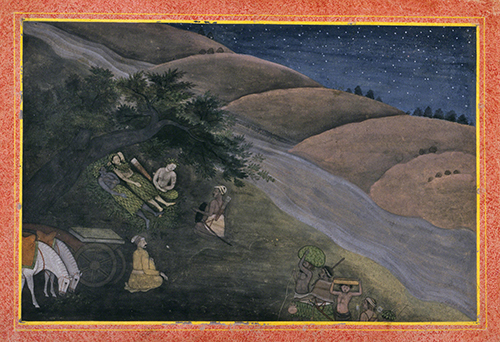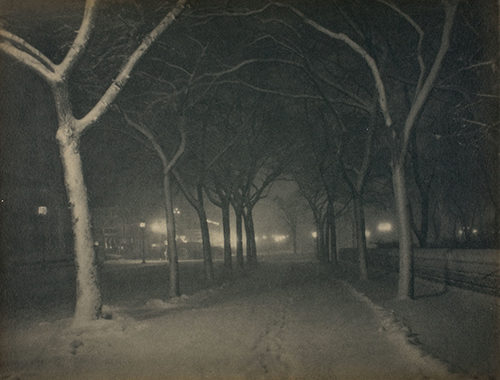Daylight Saving Time Gone: Night
Monday, I celebrated dusk in works of art to mark moving the clocks back over the weekend. Today, no more dusk. Now to show you a couple of interesting night scenes.
 |
| India, The First Night in Exile, from a dispersed series of illustrations for a Ramayana (Journey of Rama), ca. 1775–1780. Opaque watercolor on paper, sheet: 9 9/16" x 13 13/16" (24.4 x 35.2 cm). © 2019 Brooklyn Museum. (BMA-1126) |
The Ramayana is one of the most beloved texts illustrated in India, next to the Mahabharata (Great Epic of the Bharata Dynasty). The Ramayana is the narrative of the adventures of the god Rama (seventh avatar of Vishnu) and his love for his wife Sita (daughter of the goddess Bhūmi and adopted child of King Janaka of Videha and Queen Sunaina). The original text is thought to have been written before 300 BCE in Sanskrit by the legendary sage/poet Valmiki, whose life is dated somewhere between the 400s and 100s BCE. The poem is ultimately divided into seven books. It has been translated with illustrations into many vernacular languages in India, and there is a Buddhist version.
This page represents a scene from the second book of the Ramayana, Ayodhya Kanda. Ayodhya was the father of Rama. In exile because of the jealousy of one of Ayodhya’s other wives (not Rama’s mother), Rama and Sita were forced to wear leaves for clothing. Here they are shown being ministered to by local rural people. In this image, Bharata (son of King Dushyanta and Shakuntala) and Sita are depicted with white skin, indicating that they are not divine like Rama, who has blue skin as the god Krsna is always depicted. The artist painted this in the typically bright Kangra palette, and then applied a delicate wash of blue-gray over the whole to indicate that it was nighttime.
In the Punjab region, after the decline in influence from the waning Mughal Empire (1700s) and dominated by local princes, the various courts developed styles that were a synthesis of the Mughal and indigenous Rajput painting styles. These styles featured a blending of the real and the conceptual. Kangra paintings of Himachal Pradesh in the Punjab region belong to the school sometimes called Pahari Painting. Pahari (“mountain”) refers to the mountains of northeastern India, leading to the Himalayas.
Kangra painting is known for the lush forest landscapes and depictions of nature with great attention paid to detail. What influence of Mughal painting there is in this work is seen in the logically depicted space with figures in proportion to the tree. Kangra painters used a variety of fresh colors for their works. One typical feature of this school is the use of a salmon color for distant hills.
 |
| Alfred Stieglitz (1865–1946, US), An Icy Night, New York, 1898. Carbon print on paper, 10 ¼" x 13 3/8" (26 x 34 cm). © 2019 Art Institute of Chicago. (AIC-399) |
Early in the development of photography, English photographer Paul Martin (1864–1944) showed his night photographs at the 1896 Royal Photographic Society exhibition and published his methods in the Amateur Photographer. His technique at the time was without the benefit of additional gas or electric light.
The pioneering Pictorialist Alfred Stieglitz (1864–1946) also experimented with night scenes around the same time. In contrast to Martin’s exposure time of half an hour, his was 58 seconds. Stieglitz ignored Martin’s long exposure because the British artist had attempted to achieve clear images of streetlights without the fuzzy glow of light around them. Stieglitz embraced that halo effect for aesthetic purposes. Stieglitz believed that a night scene with a certain amount of “halo” around the light sources gave a “more sincere and picturesque rendering of the object itself.”1
Stieglitz, born in Hoboken to German immigrants, studied photography while spending time in Germany in the 1880s. When he returned to New York in 1890, his photography reflected an overriding interest in expressing visual truth, and in recognition of photography as a legitimate means of artistic expression. He also became involved in efforts to expose Americans to modern art movements from Europe, opening Gallery 291 from 1903–1917, in which he exhibited the work of Pictorialists and other avant-garde photographers.
Stieglitz's efforts to improve the way photographs were exhibited and printed in magazines had a lasting impact on the recognition of photography as an art form. His greatest achievement, grounded in Pictorialism, was to take subjects previously considered devoid of charm and elevate them to a level of aesthetic refinement.
1 Alfred Stieglitz, “Night Photography with the Introduction of Life,” American Annual of Photography and Photographic Times Almanac for 1898, reprinted in Richard Whelan, ed., Stieglitz on Photography: His Selected Essays and Notes (Aperture, 2000), p. 83, via the Art Institute of Chicago website.


Comments